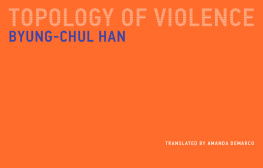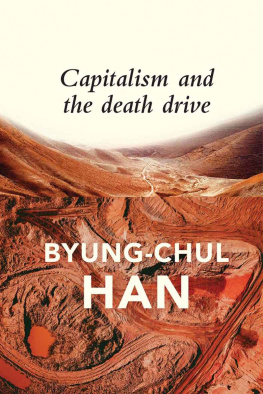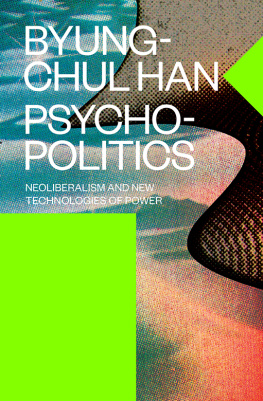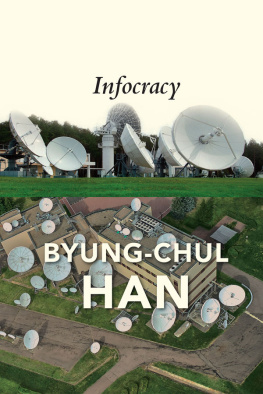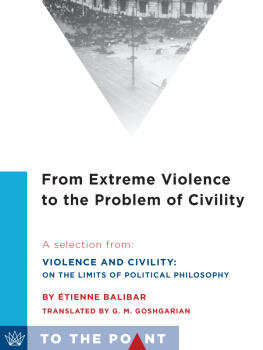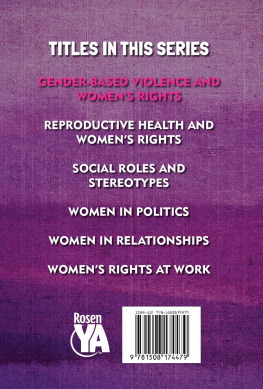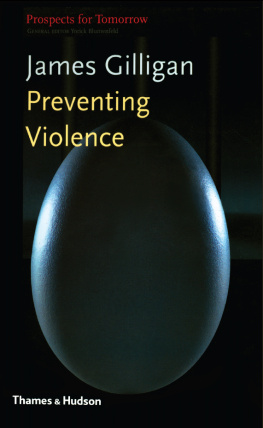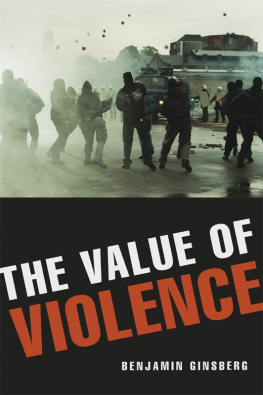Untimely Meditations
1.The Agony of Eros
Byung-Chul Han
2.On Hitlers Mein Kampf: The Poetics of National Socialism
Albrecht Koschorke
3.In the Swarm: Digital Prospects
Byung-Chul Han
4.The Terror of Evidence
Marcus Steinweg
5.All and Nothing: A Digital Apocalypse
Martin Burckhardt and Dirk Hfer
6.Positive Nihilism: My Confrontation with Heidegger
Hartmut Lange
7.Inconsistencies
Marcus Steinweg
8.Shanzhai: Deconstruction in Chinese
Byung-Chul Han
9.Topology of Violence
Byung-Chul Han
10.The Radical Fool of Capitalism: On Jeremy Bentham, the Panopticon, and the Auto-Icon
Christian Welzbacher
Topology of Violence
Byung-Chul Han
Translated by Amanda DeMarco
The MIT Press
Cambridge, Massachusetts
London, England
2018 Massachusetts Institute of Technology
Originally published as Topologie der Gewalt in the series Batterien Neue Folge by Matthes & Seitz Berlin: Matthes & Seitz Berlin Verlagsgesellschaft mbH, Berlin 2011. All rights reserved.
All rights reserved. No part of this book may be reproduced in any form by any electronic or mechanical means (including photocopying, recording, or information storage and retrieval) without permission in writing from the publisher.
This book was set in PF Din Text Pro by Toppan Best-set Premedia Limited. Printed and bound in the United States of America.
Library of Congress Cataloging-in-Publication Data
Names: Han, Byung-Chul, author. | DeMarco, Amanda, translator.
Title: Topology of violence / Byung-Chul Han ; translated by Amanda DeMarco.
Other titles: Topologie der Gewalt. English
Description: Cambridge, MA : MIT Press, [2017] | Series: Untimely meditations | Translation of: Topologie der Gewalt. | Includes bibliographical references.
Identifiers: LCCN 2017026378 | ISBN 9780262534956 (pbk. : alk. paper)
eISBN 9780262345057
Subjects: LCSH: Violence. | Power (Social sciences)
Classification: LCC HM886 .H34513 2017 | DDC 303.6--dc23 LC record available at https://lccn.loc.gov/2017026378
ePub Version 1.0
Introduction
There are things that dont disappear. Violence is one of them. Modernity is not distinguished by an aversion to violence. Violence is simply protean. It varies its outward form according to the social constellation at hand. Today it is shifting from the visible to the invisible, from the frontal to the viral, from brute force to mediated force, from the real to the virtual, from the physical to the psychological, from the negative to the positive, withdrawing into the subcutaneous, subcommunicative, capillary and neuronal space, creating the false impression that it has disappeared. It becomes completely invisible at the moment it merges with its opposite, that is, with freedom. Martial violence is currently giving way to an anonymized, desubjectified, systemic violence that conceals itself as such because it becomes one with society.
The Topology of Violence first addresses the macro-physical manifestations of violence, which take the form of negativity, developing in the relationship of tension between self and other, interior and exterior, friend and enemy. Typically these manifestations reveal themselves as expressive, explosive, massive, and martial. They include the archaic violence of sacrifice and blood, the mythical violence of jealous and vengeful gods, the sovereigns deadly violence, the violence of torture, the bloodless violence of the gas chamber, and the viral violence of terrorism. But macro-physical violence can also take a more subtle form, expressing itself as verbal violence, for example. Like physical violence, the violence of hurtful language is still based on negativity, since it is de-famatory, dis-crediting, de-grading, or dis-avowing. The violence of negativity differs from the violence of positivity, which arises from the spamification of language, excessive communication and information, and the accumulation of language, communication, and information.
Todays society increasingly divests itself of the negativity of the other or the foreign. The process of globalization accelerates the dissolution of borders and distinctions. Yet the depletion of negativity should not be equated with the disappearance of violence, since along with the violence of negativity there is a violence of positivity, which is wielded without enmity or domination. Violence isnt merely an excess of negativity; it can also be an excess of positivity, the accumulation of the positive, which manifests as overachievement, overproduction, overcommunication, hyperattention, and hyperactivity. The violence of positivity is possibly even more disastrous than that of negativity because it is neither visible nor evident, and it evades immunological defense because of its positivity. Infection, invasion, and infiltrationwhich are characteristic of the violence of negativitynow give way to infarction.
The late modern achievement-subject is free, in that it does not encounter repression on the part of sovereign entities external to itself. But in reality it is just as unfree as the obedience-subject. Once exterior repression is overcome, pressure builds within. Thus, the achievement-subject develops depression. The violence persists unabated. It merely shifts to the interior. The stages of the topological transformation of violence are decapitation in the sovereignty society, deformation in the disciplinary society, and depression in the achievement society. Violence is increasingly internalized, psychologized, and thus rendered invisible. More and more, it rids itself of the negativity of the other or the enemy, becoming self-referential.
Note
When Jan Philipp Reemtsma speaks of the aversion to violence and the delegitimation of violence in the modern, he has only raw, corporeal violence in mind. He does not take note of systemic violence or more subtle forms of violence. See Jan Philipp Reemtsma,
Vertrauen und Gewalt (Hamburg: Hamburger Edition, 2008).
I The Macro-physics of Violence
1.The Topology of Violence
The Greeks called torture . means necessary or indispensable. Torture was perceived and tolerated like fate or a law of nature (). Here we have a society that sanctioned physical violence as a means to an end. It was a society of blood, distinct from the modern society of the psyche. In it, conflicts were resolved directly through the use of violence; that is, resolution was enforced. External violence unburdens the psyche because it externalizes suffering. The psyche doesnt antagonize itself with endless internal discussion. In modernity, violence assumes a psychic, psychologized, internalized form. It takes on intrapsychic forms. Destructive energies are not directly, affectively discharged but rather worked through psychically.
Greek mythology is drenched in blood and strewn with dismembered bodies. For the gods, violence is a self-evident, even natural, means of achieving their goals and asserting their wills. Thus Boreas, the god of the north wind, justifies his violent course of action to woo Orithyia: So Boreas tried / To win by pleading, and accomplished nothing / With all his gentleness; then his natural manner, / Rough anger, rose up in him, the wind of the north, / And he growled and blustered: This is what I get, / What I deserve! I have thrown down my weapons / Fierceness and violence and angry spirit / Fine things to exchange for prayers! What use are they / To me? How unbecoming! Violence / Is my right weapon. Ancient Greece was also a culture of fervor. It is characterized by intense emotions that take on violent form. The boar that kills the beautiful youth Adonis with its tusks embodies the violence inherent in this culture of fervor and emotion. After Adonis died, the boar is supposed to have said that it in no way wanted to injure him with its eroticized teeth ( ) but rather simply wanted to caress him. This paradox would ultimately be the ruin of the culture of emotion and drives.

